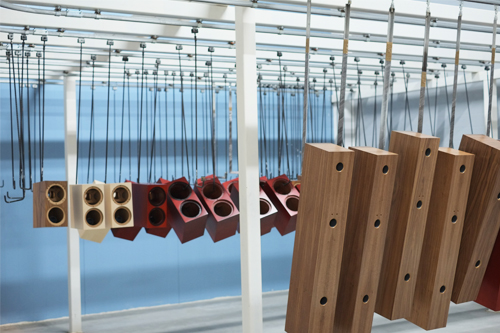Conveyor system
What is a conveyor system?
Conveyor systems are tailored according to the project requirements, which makes them versatile for different spaces and uses. A top-hung system leaves the floor spaces accessible and makes heavy objects easier to move manually.
Conveyor systems help reduce workload and improve productivity for example in production plants, the furnishing industry, agricultural buildings, studios, painting facilities, theatres and other assembly lines.
Compared to automatic lines, conveyor systems are an economical solution that are quick to install and long-lasting.
How to choose components for a conveyor system?
On this page you will find a list of components that make up a conveyor system as well as a few easy steps to selecting them. There are of course some exceptions in the series and if you have any questions feel free to contact our sales department or our distributors.
1. SLIDING TRACKS, CURVES AND SWITCHES
In conveyor systems sliding track length is determined based on the project requirements. A diverse line can be made by joining switches and curves. There are right- and left-handed switches as well as Y-rail switches. Right and left-handed switches direct the track line according to the tracks curves. Y-rail switches divide the track line to two directions: right and left. Switches are made of aluminium casting and are durable and easy to install.
Three-way rail switches are a ready-made assembly, which consists of a Y-rail switch, right and left-handed switches and two curves. This helps continue the track line with a new track in an angle of 90 ° against the main track line.
Underpass module is used in places where the track line must go beneath an object for example a beam or a pipe.
2. BRACKETS
Soffit brackets are usually used with conveyor systems. The number of brackets is determined based on the track length. In straight track lines the bracket interval is approximately 1 meter.
Conveyor systems versatile bracket selection provide solutions for different installations and materials. A high space is not a problem, since telescope brackets or brackets that enable the use of threaded bar can be used to drop the track line to the needed height. A bracket can also be fixed diagonally to the sealing, when you use it with a spacer or a wedge.
If needed you can also join two tracks with track joints or joint brackets. Using a track joint supports the track junctions and locks the track ends together.
3. HANGERS
Conveyor systems have several hanger options. The type of hanger is chosen based on how the moved object is needed to be fixed.
LP and LPU hangers are meant for conveyor systems where the track lines, switches and Y-rails are used since the LPU hangers guiding wheels can effortlessly direct the movement. KVLP hangers have a pivoting holder, which means that the hanging object can move more freely. KV hanger has been made from two separate 2-wheeled hangers that are joined with a sturdy flat bar with a lateral fixing hole.
4. TRACK STOPS
Conveyor systems typically include tracks stops on both ends of the sliding track to stop the hangers from falling of the track.
If any questions, you can contact our sales department or our distributors.